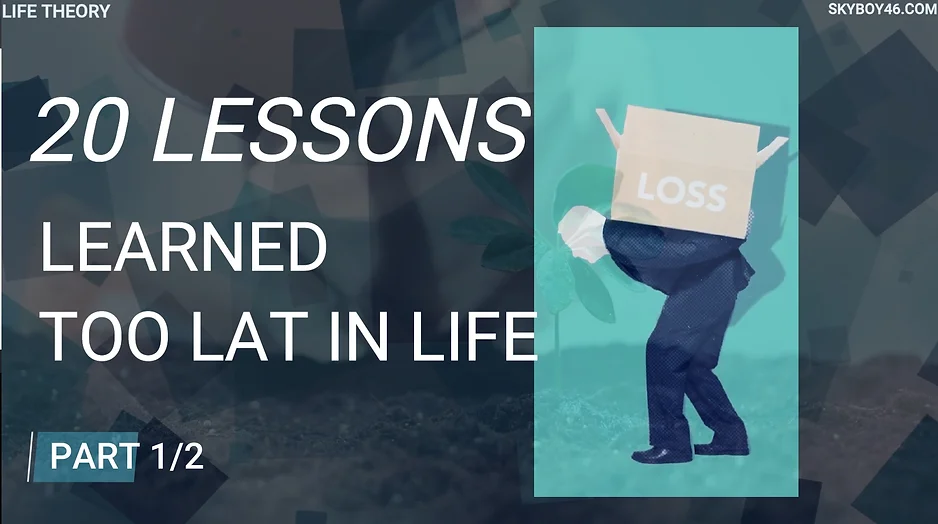Have you ever wondered why so many managers seem unqualified for their roles? The answer lies in the Peter Principle—the unsettling truth that employees rise to their level of incompetence. In a system where promotions reward past performance rather than future potential, businesses end up with leaders who are out of their depth. But what if climbing the corporate ladder isn’t the only path to success? Understanding this flaw in leadership structures can help individuals and companies break free from the cycle and create workplaces that prioritize the right skills over blind promotion.
SUBSCRIBE: https://www.youtube.com/@LifeTheory46
VISIT: https://linktr.ee/lifetheory46
Get You Monthly Life Stories in Advance & Our Premium Learning Packs HERE:
Breaking the Cycle of Ineffective Leadership – Life Stories 322
Let’s face it—at some point in your career, you’ve likely found yourself under the leadership of a manager who just didn’t seem to know what they were doing. It can be disheartening, especially when you’ve hustled hard to land the job, only to realize that the higher-ups, the supposed experts, appear utterly lost. If you’ve ever felt like you’re the only one who notices these gaps in competence, rest assured—you’re not alone. There’s actually a name for this phenomenon, and it reveals a lot about the flawed nature of corporate structures.
This unsettling reality is explained by a concept known as the Peter Principle. It’s the idea that in hierarchical organizations, employees keep getting promoted based on their current performance until they reach a position where they are no longer competent. It’s a paradox—promotions happen because someone is good at what they do, but once they’ve been advanced to a point where their existing skills no longer suffice, they stagnate. Essentially, employees rise to their level of incompetence.
Think about it: a fantastic front-office secretary, known for being organized, efficient, and great with people, gets promoted to executive assistant to the CEO. It seems like a logical step. After all, the roles share some similarities, but they also diverge in critical ways that may not align with what made that secretary excel in the first place. It’s not necessarily that they can’t handle the new job; it’s that the skills required to thrive in this new role may be entirely different from the ones they mastered before.
This principle means that eventually, most positions in an organization get filled by individuals who aren’t fully equipped to meet the demands of the role. And that’s when frustration sets in—for both employees and their managers. You see it every time someone steps into a corporate environment and quickly realizes that the people in charge aren’t necessarily the smartest or most capable individuals in the room. It’s not that they aren’t trying; it’s just that the demands of the job may have outgrown their skill set.
Dr. Laurence J. Peter, who first introduced the concept in his book The Peter Principle, pointed out that an employee’s shortcomings are not always due to laziness or incompetence. Often, it’s because the new role simply calls for a different set of abilities than the person has. It’s an important shift in perspective. We’re so quick to judge managers who seem to fumble through tasks, but maybe they’re just as overwhelmed as the people they’re supposed to lead.
Consider how people end up in these roles in the first place. Performance metrics usually dictate promotions. If you’re great at your job, you’ll get noticed and eventually moved up the ladder. But when you’re promoted to a level where your skill set no longer meets the job requirements, you’re suddenly being evaluated not on what you do best, but on whether you show up on time, follow the rules, and play well with others. That’s not a recipe for growth; it’s a setup for stagnation.
To truly tackle the Peter Principle, we first need to shift our mindset about promotions and career progression. Moving sideways—or even stepping down—shouldn’t be seen as a failure. It’s about finding the role that fits you best, where your strengths can shine without the frustration of hitting a glass ceiling. Recognizing that it’s okay to realign your career path can be a game-changer.
Training is also critical. No matter how excellent someone is in their current role, transitioning to a new position will inevitably come with different challenges. Investing in skills development for employees making these moves is key. Training shouldn’t just be a box to check; it should be a fundamental part of any promotion to ensure that the employee is genuinely prepared for what lies ahead.
Organizations must also foster a culture where lateral moves are not seen as setbacks. If a role doesn’t suit your strengths or you find yourself struggling, the solution isn’t always to push through. Sometimes the best move is to step aside into a position that allows you to thrive. After all, growth isn’t just about moving up—it’s about finding the place where you’re continuously learning and succeeding.
The Peter Principle reminds us that even the most competent among us will eventually reach a point where our skills and the job requirements no longer align. The key is recognizing when we’ve hit that ceiling and having the courage to find the right path forward—whether that means moving up, down, or sideways. Don’t trap yourself in a role that doesn’t fit. Keep aiming for a space where you’re challenged but still thriving, and where your talents don’t just go to waste, but shine.
–> Read More Life Stories Here:
https://www.lifetheory.us
https://www.lifetheory.eu
Buy all of our Life Stories & Our Premium Learning Packs. Listen or Read to them anytime you want. Have them Forever.
You can get each monthly lesson on our website at https://www.skyboy46.com/store
SHARE THIS STORY
Visit Our Store
SHOP NOW
www.skyboy46.com & www.myskypet.com
Designed For Pet Lovers & Introverted Souls
Sport, Hobbies, Motivation, Music & Art






~EXPLORE MORE~
www.linktr.ee/skyboy46


